- 1. What is Space Medicine?
- 2. Physiological Changes in Space
- 3.
Flight Surgeon; FS
- 4. Health Care for Astronauts
- 5. Spin-offs
- 6.
Conclusion
- Space medicine booklets

-
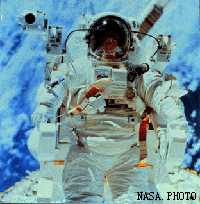
Manned space missions used to be the dream of mankind for years, but became reality
with the blast-off by Y. Gagarin in 1961 and the first small steps on the moon
by N. Armstrong on Apollo 11. Since then, human activity in space has increased
steadily. More than 200 people have been to space, and the duration of stays in
space has progressed from 2 hours to more than a year. Now we are entering a new
era: the 21st century International
Space Station (ISS). Those who have been to space so far are highly specialized,
dedicated "astronauts,"
but in the 21st century, common citizens will be able to travel and sight-see
or to live in space. However, before space can become a safe, habitable place,
we must solve so many problems. Here we have a powerful tool which will establishes
the countermeasures to overcome the physiological effects in space, and that is
"Space Medicine." |

-
 |
The physiological changes in the adaptive process to space mainly involve:
-
|
-
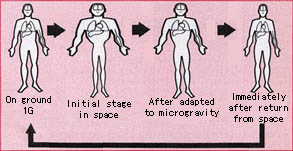 |
Fluid shift and the change
of body
mass caused by spaceflight | cited
from "The Bone"(Vol. 11 No.2 1997.6)
Medical View Co., Ltd. |
Human beings living on Earth are effected by gravity because about
two-thirds of our daily activities are standing or sitting. Great amounts of body
fluids such as blood pool in the lower part of the body. The human body is equipped
with various mechanisms to oppose gravity to maintain sufficient blood flow to
the brain.
In microgravity environment, the quantity and the distribution
of body fluid alter, being free of the gravitational effect. This is the concept
of "fluid shift." |
-
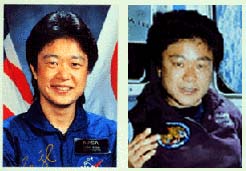
This figure shows photographs of Dr.
Chiaki Mukai, JAXA astronaut, on Earth and in space. Facial
edema, especially around the eyes, appears and the cranial veins
dilate early in spaceflight. Subjective symptoms caused by fluid
shift are stuffy nose, headache, and puffy face.
Because of this fluid shift in the early stage of spaceflight, the thick veins
such as central veins dilate, which is interpreted by the body as an overall increment
of the circulating volume. This activates mechanisms which counteract hypervolemia,
leading to a significant loss of water.
It is expected that despite the fluid
shift and the consequent loss of body mass in the early stage of spaceflight,
the cardiovascular system adapts to the microgravity environment if the astronaut
continues to stay in space.
However, on return to Earth, the fluid shifts
rapidly to the lower body again, which causes a tendency to develop orthostatic
hypotension and syncope. Technically speaking, this is called "orth ostatic
intolerance." |
-

One countermeasure is to apply the Lower Body Negative Pressure (LBNP). This provides
an equivalent physiologic stress by creating suction on the lower body (i. e.,
legs and abdominal regions) as a substitute for Earth gravity and the upright
exercise on Earth. Ingestion of isotonic saline just before reentry is also thought
to be effective.
Orthostatic intolerance and the loss of exercise capacity
after spaceflight are thought to be caused by overall changes in the cardiovascular
system. The process leading to the appearance of these symptoms is called "cardiovascular
deconditioning." Significant countermeasures have been made so that the astronauts
should not suffer from syncope when the Space Shuttle returns to the Earth. |
-
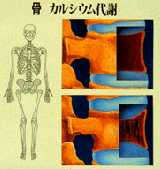
Bones are important systems involved in locomotion and posture maintenance under
1G. The adult human body has 1,000 to 1,200 grams of calcium and 400 to 500 grams
of phosphorus. More than 99% of the calcium exists in the form of hydroxyapatite
in bone, whereas approximately 85% of phosphorus exists in bone. Thus, bone tissue
stocks calcium and phosphorus. However, once gravitational stress is removed,
bone calcium and phosphorus are excessively excreted in urine and feces. It is
reported that 3.2% of average bone loss occurred after nearly 10 days of weightlessness.
The loss of calcium in urine may produce urinary stone which might cause severe
pain; the decrease of bone density will lead to bone fracture. Therefore, countermeasures
are necessary.
One countermeasure proposed to prevent bone loss is onboard
exercise (training program) mainly with the treadmill and ergometer.
For future
spaceflight, nutritional supplements and medications might be administrated. The
bone research advanced due to aerospace medicine contributes to the research on
osteoporosis, which is increasing yearly on Earth. |
- The human
body floats within the orbiting spacecraft. Therefore, astronauts can move around
in spacecraft just by softly pushing against its wall. In a microgravity environment,
muscles rapidly atrophy due to the lack of use.
Muscles can be roughly classified
into anti-gravity muscles which support body weight and other muscles. The former
are composed of slow-twitch muscle fibers, and the latter, fast-twitch muscle
fibers.
The characteristic changes in muscles in microgravity are the rapid
degradation of anti-gravity muscle and the transformation of slow-twitch muscle
fibers into fast-twitch muscle fibers. Considering the characteristic of the anti-gravity
muscle, exercise to prevent muscle atrophy is not short-duration intensive training,
but should be designed to expend less than 30% of the maximum muscle power continuously
over a long duration. It is a matter of course that simpler training methods with
maximum effects should be established for the coming ISS era.
- A few minutes or a few hours
after entering weightlessness, some astronauts experience space motion sickness,
which is characterized by headaches, malaise, nausea and eventually vomiting.
Sixty to seventy percent of the astronauts experience these symptoms which recur
intermittently during the first or second day, but then disappear on the third
to fifth day.
How do these very distressing conditions occur? Various hypotheses
have been proposed for the cause of space motion sickness. The basic mechanisms
responsible for developing space motion sickness are assumed to be the rearrangement
of the relationship among signals from the vestibular system of the inner ear,
visual, skin, joint and muscle receptors by the exposure to microgravity. It has
also been proposed that fluid-shift theory should be involved in the development
of space motion sickness.
In the 1960s, pre-flight adaptation training with
a rotating chair was proposed as a means to build up tolerance to motion sickness
by researchers. However, it proved to be not so effective and is no longer used
by NASA. We are still groping for the best countermeasure. Biofeedback training,
adaptation training using virtual reality, and water immersion training have been
attempted so far.
Once astronaut is suffering from space motion sickness,
promethazine hydrochloride, which is about 30 times as effective as commonly-used
travelmine, is usually administered to reduce the discomfort. Through researches
on space motion sickness, these findings contribute to research on dizziness and
ground motion sickness.
-
One significant alteration in the
hematologic and immunologic system in microgravity is the transformation of red
blood cells, the main component of blood. Ninety percent of our normal erythrocytes
have a biconcave discoid shape (i.e.) a doughnut without a hole. In weightlessness,
some erythrocytes transform into "mulberry" or spheric shapes. However,
they are readily reversed even after long-term space mission. Anemia characterized
by a decrease in the number of red blood cells is observed within four days of
spaceflight. The number of red blood cells decreases by approximately 15% after
a three-month spaceflight with few subjective symptoms, then recovers after return
to the Earth. The activity of lymphocytes, which counteract against the invasion
of microorganisms, slightly reduces, but this rarely causes practical problems.
- Space radiation exists in the space environment. On the Earth, the atmosphere
and magnetic field provide a shield for humans, and prevent space radiation from
penetrating to the Earth's surface. Due to the absence of such shielding in the
space environment, astronauts are subject to greater amounts of space radiation
than they would receive on the Earth. Therefore, the space radiation may seriously
affect on astronauts.
-
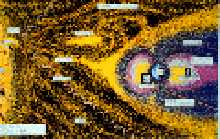
The various types of space radiation can be broadly classified as: 1) galactic
radiation coming from outside our solar system, 2) solar-particle radiation originating
from the Sun, 3) geomagnetically trapped radiation surrounding the Earth in the
plane of the geomagnetic equator. The radiation intensities are not always constant,
varying incessantly according to the solar activity.
High-energy solar protons
and heavy ions are emitted sporadically during solar-particle events (flares),
and this represents a very serious hazard for manned spaceflight. |

In order to minimize the exposure to such space radiation, the penetration capability
must be predicted by measuring the intensity of the radiation and by identifying
the type. Astronauts must shelter themselves from the radiation behind walls of
sufficient thickness in the space vehicle, especially for the flares. In addition,
it is essential to limit flight opportunities and durations to achieve permissible
radiation exposure levels for preventing potential damage, to monitor exposure
level with personal dosimeters, and to establish practical risk management procedures.
It is expected that these research activities related to space radiation will
be applied to the health care of passenger plane pilots, who also affected by
space radiation, as well as to the research for utilizing and shielding radiation
sources in high-energy radiation facilities. |
- On ISS, crew members
of different nationalities will live together, perform experiments of various
types together, and operate the space craft together in a confined place for three
to six months. Psychologically speaking, the environment is different from that
on ground in that they must manage to work according to a tight schedule in a
monotonous room for several months without a free break back to the Earth, while
getting along with other crew members of different cultural backgrounds. It is
expected that the long-term confined environment may induce severe psychological
stress on international crew members.
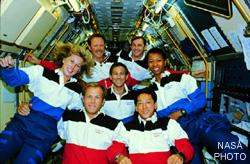 Psychological
considerations must therefore be introduced into the selection criteria for astronauts
to select out applicants who possess predisposed tendencies for any emotional
disorders under psychological stresses. It is a matter of course that there is
also significant demand for effective crew organization of high-level team performance
based on psychological compatibility. Psychological
considerations must therefore be introduced into the selection criteria for astronauts
to select out applicants who possess predisposed tendencies for any emotional
disorders under psychological stresses. It is a matter of course that there is
also significant demand for effective crew organization of high-level team performance
based on psychological compatibility.
Psychological considerations must therefore
be introduced into the selection criteria for astronauts to select out applicants
who possess predisposed tendencies for any emotional disorders under psychological
stresses. It is a matter of course that there is also significant demand for effective
crew organization of high-level team performance based on psychological compatibility.
The leadership required is not always the same type: for short-term missions,
performance-oriented leadership has been required, but for extended-duration missions,
democratic leaders, who have social sensitivity and deep concern for others' feelings,
have displayed greater talents. The psychological status of the crew members is
a significant key to mission success, with great effect on work efficiency and
sound sleep.
Experience gained from previous spaceflights by FKA
has revealed conflicts among crew members 30 days after launch,
showing hostility to each other and quarreling. Conflicts
also arise between crew members and the ground team; in one
case, the crew even went on strike against the ground team.
Psychological supports, such as private psychological counseling
and periodic spouse and family conferences with two-way voice
and video communication, are provided as countermeasures.
As the number of those who have experienced spaceflight is
limited, there is much to be learned about the effect of spaceflight
on mental health. However, it is possible to simulate spaceflight
in long-term isolation experiments on the ground, though there
is a limitation in that the effect of weightlessness can not
be taken into consideration. JAXA constructed the Isolation
Chamber and initiated basic experiments on adaptation training
with several volunteers. We are thus attempting to utilize
the knowledge of psychology and psychiatry accumulated so
far to solve the problems of psychological adaptation to spaceflight. |

Last Updated :April 19, 2004
|





